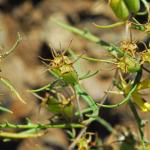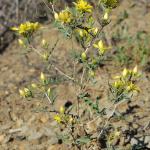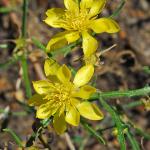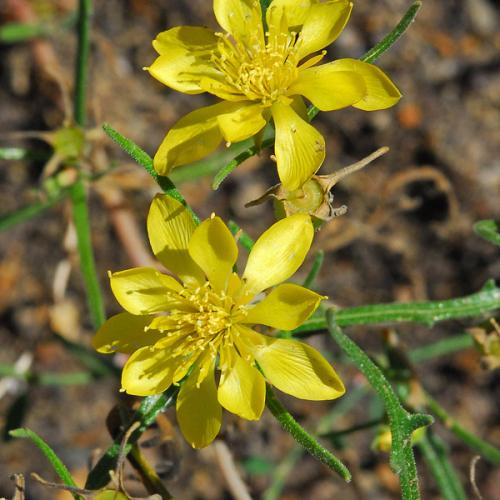Mentzelia sivinskii (Sivinski's Blazingstar)
Mentzelia linearifolia Welsh & Atwood
| USFWS | State of NM | USFS | BLM | Navajo Nation | State Rank | Global Rank | R-E-D Code | NMRPTC Status | Strategy Status |
|---|---|---|---|---|---|---|---|---|---|
| SEN | S3 | G3 | SS |
| Overall Conservation Status | Documented Threats | Actions Needed |
|---|---|---|
| UNDER CONSERVED | No Information |
document rarity |
Biennial taprooted herbs; stems solitary, erect, straight; branches distal or along entire stem (candelabra-form); leaf blades 32.8-112.2 x 2.9-11.4 mm, intersinus distance at widest point 1-2.9 mm; proximal oblanceolate to elliptic, margins pinnate, lobes 18-24, perpendicular to leaf axis, 0.8--4 mm, distal elliptic to linear-lanceolate, base not clasping, margins entire or pinnate, lobes 6--16, perpendicular to leaf axis, 1--5.1 mm, abaxial surface with simple grappling-hook, complex grappling-hook, and needlelike trichomes, adaxial surface with needlelike and occasionally simple grappling-hook trichomes; inflorescence bracts entire; flower petals golden yellow, 9-14.7 x 3.1-6.4 mm, apex rounded, glabrous abaxially; stamens golden yellow, 5 outermost petaloid, slightly clawed, narrowly spatulate, 6.3-11.5 x 2.4-4.9 mm, usually with, rarely without, anthers; anther epidermis not papillate; styles 4.6-9.9 mm; capsules cup-shaped, 8.2-12.7 x 5.1-7.7 mm, base tapering to rounded, not longitudinally ridged; seed coat anticlinal cell walls sinuous, papillae 12-21 per cell. Flowers from May to October.
Mentzelia sivinskii is distinguished from other similar Mentzelia species on the southeastern Colorado Plateau by its combination of entire inflorescence bracts, glabrous petals, and anthers on the petaloid stamens (2nd whorl after 5 outer petals). Most other species have a 2nd whorl of petaloid staminodes without anthers.
New Mexico: San Juan County; Colorado: La Plata and Montezuma counties.
Generally barren sandy shale (sometimes gypseous) on road cuts and slopes and hills in piñon-juniper woodland and salt scrub; 1,500-2,100 m (4,900-6,900 ft) elevation.
Most frequent on the Nacimiento Formation from the Angel Peak badlands north to the Colorado border.
Occasionally occurs with Aliciella formosa. Most known populations are within regions of active natural gas well fields. The species sometimes recolonizes disturbed soils associated with roads and pipelines.
*Schenk, J.J. and L. Hufford. 2011. Taxonomic novelties from western North America in Mentzelia section Bartonia (Loasaceae). Madroño 57:246-260.
For distribution maps and more information, visit Natural Heritage New Mexico




